Characteristics of Micropore-Throat Structures in Tight Oil Reservoirs: A Case Study of the Jiufotang Formation in the Houhe Region, NE China
Abstract
:1. Introduction
2. Geological Setting
3. Materials and Methods
3.1. Sample Information
3.2. Testing Methods
3.2.1. Petrological Analysis
3.2.2. Thin Sections, Dyed Thin Sections, and SEM Analyses
3.2.3. Analysis of Routine Physical Properties
3.2.4. CT Analysis
3.2.5. High-Pressure Mercury Intrusion Analysis
4. Results
4.1. Reservoir Petrology
4.2. Physical Characteristics of the Reservoir
4.3. Types of Reservoir Pore Spaces
4.4. Characterization of Pore-Throat Structures Based on Micron-Scale CT Scanning
4.5. Pore-Throat Structure Analysis Based on High-Pressure Mercury Intrusion Tests
5. Discussion
5.1. Classification of Pore-Throat Structures in the Tight Oil Reservoir
5.2. Analysis of Factors Controlling Tight Oil Reservoirs
5.2.1. Depositional Environment
5.2.2. Diagenesis
5.2.3. Tectonic Activity
6. Conclusions
Author Contributions
Funding
Data Availability Statement
Acknowledgments
Conflicts of Interest
References
- Liu, Y.; Lu, Z.; Feng, M.; Wang, J.; Tian, T.; Chao, J. Micro-pore Characteristics of Shale Oil Reservoirs of the Shahejie Formation in the Dongying Sag, Bohai Bay Basin. Acta Geol. Sin. 2017, 31, 629–644. [Google Scholar]
- Yang, Y.; Xiao, W.; Zheng, L.; Lei, Q.; Qin, C.; He, Y.; Liu, S.; Li, M.; Li, Y.; Zhao, J.; et al. Pore throat structure heterogeneity and its effect on gas-phase seepage capacity in tight sandstone reservoirs: A case study from the Triassic Yanchang Formation, Ordos Basin. Petrol. Sci. 2023, 20, 2892–2907. [Google Scholar] [CrossRef]
- Du, M.; Yang, Z.; Yang, S.; Feng, C.; Wang, G.; Jia, N.; Li, H.; Shi, X. Study on the Quantitative Characterization and Heterogeneity of Pore Structure in Deep Ultra-High Pressure Tight Glutenite Reservoirs. Minerals 2023, 13, 601. [Google Scholar] [CrossRef]
- Wu, S.; Zhu, R.; Li, X.; Jin, X.; Yang, Z.; Mao, Z. Evaluation and Application of Porous Structure Characterization Technologies in Unconventional Tight Reservoirs. Earth Sci. Front. 2018, 25, 191–203, (In Chinese with English Abstract). [Google Scholar]
- Zhang, X.; Ma, F.; Wang, H.; Wang, K.; Li, W.; Qin, Y. Accumulation Laws of Recoverable Resources in Typical Tight Oil Zones in North America. China Petrol. Explor. 2018, 4, 58–66. [Google Scholar]
- Deaf, A.S.; Tahoun, S.S. Integrated Palynological, Organic Geochemical, and Sequence Stratigraphic Analyses of the Middle to Upper Cenomanian Hydrocarbon Reservoir/Source Abu Roash “G” Member: A Depositional Model in Northwestern Egypt. Mar. Petrol. Geol. 2018, 92, 372–402. [Google Scholar] [CrossRef]
- Atwah, I.; Mohammadi, S.; Moldowan, J.M.; Dahl, J.E.P. Episodic Hydrocarbon Charge in Tight Mississippian Reservoirs of Central Oklahoma, USA: Insights from Oil Inclusion Geochemistry. Mar. Petrol. Geol. 2021, 123, 104742. [Google Scholar] [CrossRef]
- Wilkinson, W.M. Fracturing in Spraberry Reservoir, West Texas. AAPG Bull. 1952, 2, 250–265. [Google Scholar]
- Hu, Q.; Quintero, R.P.; El-Sobky, H.F.; Kang, J.; Zhang, T. Coupled Nano-petrophysical and Organic-Geochemical Study of the Wolfberry Play in Howard County, Texas USA. Mar. Petrol. Geol. 2020, 122, 104663. [Google Scholar] [CrossRef]
- Sonnenberg, S.A. The Bakken–Three Forks Super Giant Play, Williston Basin. AAPG Bull. 2020, 104, 2557–2601. [Google Scholar] [CrossRef]
- Lindsay, R.F. Madison Group (Mississippian) Reservoir Facies of Williston Basin, North Dakota. AAPG Bull. 1985, 2, 279–280. [Google Scholar] [CrossRef]
- Roth, K.W. Development in the Nesson Anticline Area, North Dakota. AAPG Bull. 1953, 11, 2616. [Google Scholar]
- Abdi, Z.; Rimmer, S.M.; Rowe, H.D.; Nordeng, S. Controls on Organic Matter Accumulation in the Bakken Formation, Williston Basin, USA. Chem. Geol. 2021, 586, 120588. [Google Scholar] [CrossRef]
- Sonnenberg, S.A.; Theloy, C.; Jin, H.; Jia, B.; Tsau, J.S.; Barati, R.; Jia, B.; Tsau, J.S.; Barati, R.; Temizel, C.; et al. The Giant Continuous Oil Accumulation in the Bakken Petroleum System, U.S. Williston Basin. AAPG Mem. 2017, 113, 91–119. [Google Scholar]
- Zhong, J.; Alibakhshi, M.A.; Xie, Q.; Riordon, J.; Xu, Y.; Duan, C.; Sinton, D. Exploring Anomalous Fluid Behavior at the Nanoscale: Direct Visualization and Quantification via Nanofluidic Devices. Acc. Chem. Res. 2020, 53, 347–357. [Google Scholar] [CrossRef]
- Hu, X.; Wang, J.; Zhang, L.; Xiong, H.; Wang, Z.; Duan, H.; Yao, J.; Sun, H.; Zhang, L.; Song, W.; et al. Direct Visualization of Nanoscale Salt Precipitation and Dissolution Dynamics during CO2 Injection. Energies 2022, 15, 9567. [Google Scholar] [CrossRef]
- Zhong, J.; Duan, H.; Wang, J.; Ma, B.; Sun, Z.; Yao, J. Simulation of Water Self-Imbibition in Nanometer Throat-Pore Structure Filled with Oil. Geoenergy Sci. Eng. 2023, 221, 211370. [Google Scholar] [CrossRef]
- Yao, J.; Ding, Y.; Sun, H.; Fan, D.; Wang, M.; Jia, C. Productivity Analysis of Fractured Horizontal Wells in Tight Gas Reservoirs Using a Gas-Water Two-Phase Flow Model with Consideration of a Threshold Pressure Gradient. Energy Fuels 2023, 37, 8190–8198. [Google Scholar] [CrossRef]
- Wang, Z.; Liu, T.; Liu, S.; Jia, C.; Yao, J.; Sun, H.; Yang, Y.; Zhang, L.; Delshad, M.; Sepehrnoori, K.; et al. Adsorption Effects on CO2-Oil Minimum Miscibility Pressure in Tight Reservoirs. Energy 2024, 288, 129815. [Google Scholar] [CrossRef]
- Bjørlykke, K. Relationships between Depositional Environments, Burial History and Rock Properties. Some Principal Aspects of Diagenetic Process in Sedimentary Basins. Sediment. Geol. 2014, 301, 1–14. [Google Scholar] [CrossRef]
- Li, G.; Lei, Z.; Dong, W.; Wang, H.; Zheng, X.; Tan, J. Progress, Challenges and Prospects of Unconventional Oil and Gas Development of CNPC. China Petrol. Explor. 2022, 27, 1–11. [Google Scholar]
- Cai, L.; Xiao, G.; Lu, S.; Wang, J.; Wu, Z. Spatial-Temporal Coupling between High-Quality Source Rocks and Reservoirs for Tight Sandstone Oil and Gas Accumulations in the Songliao Basin, China. Int. J. Min. Sci. Technol. 2019, 29, 387–397. [Google Scholar] [CrossRef]
- Wang, R.; Tang, Y. Study on the Rock Physical Mechanical Properties Evaluation of Tight Oil Reservoir in Chang 7 Member, Longdong Area, Ordos Basin, China. Front. Earth Sci. 2024, 12, 1342561. [Google Scholar] [CrossRef]
- Peng, Y.; Zhang, H.; Zheng, X.; Wang, Y.; Li, J.; Zhu, Y.; Doolen, Q. Sedimentary Facies Evaluation of Tight Oil Reservoirs of Yanchang Formation in the Ordos Basin. J. Chem. 2023, 2023, 1–11. [Google Scholar] [CrossRef]
- Zhao, W.B.; Hu, S.Y.; Deng, X.Q.; Bai, B.; Tao, S.Z.; Sun, B.; Wang, Q.R.; Cheng, D.X. Physical Property and Hydrocarbon Enrichment Characteristics of Tight Oil Reservoir in Chang 7 Division of Yanchang Formation, Xin’anbian Oilfield, Ordos Basin, China. Petrol. Sci. 2021, 18, 1294–1304. [Google Scholar] [CrossRef]
- Zhao, X.; Yang, Z.; Zhou, S.; Luo, Y.; Liu, X.; Zhang, Y.; Lin, W.; Xiao, Q.; Niu, Z. Research on Characterization and Heterogeneity of Microscopic Pore Throat Structures in Tight Oil Reservoirs. ACS Omega 2021, 6, 24672–24682. [Google Scholar] [CrossRef] [PubMed]
- Wang, Z.; Ge, H.; Wei, Y.; Wang, Y.; Jia, K.; Xu, N.; Zhang, Y.; Du, S. Characterizing the Microscopic Anisotropic Permeabilities of Tight Oil Reservoirs Impacted by Heterogeneous. Miner. Energ. 2022, 15, 6552. [Google Scholar] [CrossRef]
- Li, Y.; Yang, K.; Wang, S.; Ye, Z.; Yang, J. Oil shale enrichment mechanisms in the Lower Cretaceous Jiufotang Formation from the Ludong sag, Songliao Basin, Northeast China. Mar. Petrol. Geol. 2024, 167, 106984. [Google Scholar] [CrossRef]
- Aliakbardoust, E.; Rahimpour-Bonab, H. Effects of pore geometry and rock properties on water saturation of a carbonate reservoir. Pet. Sci. Eng. 2013, 112, 296–309. [Google Scholar] [CrossRef]
- Thota, S.T.; Islam, M.A.; Shalaby, M.R. Reservoir quality evaluation using sedimentological and petrophysical characterization of deep-water turbidites: A case study of Tariki Sandstone Member, Taranaki Basin, New Zealand. Energy Geosci. 2022, 4, 13–32. [Google Scholar] [CrossRef]
- Tian, H.; He, K.; Huangfu, Y.; Liao, F.; Wang, X.; Zhang, S. Oil content and mobility in a shale reservoir in Songliao Basin, Northeast China: Insights from combined solvent extraction and NMR methods. Fuel 2024, 357, 129678. [Google Scholar] [CrossRef]
- Zou, C.; Zhu, R.; Liu, K.; Su, L.; Bai, B.; Zhang, X.; Yuan, X.; Wang, J. Tight gas sandstone reservoirs in China: Characteristics and recognition criteria. Pet. Sci. Eng. 2012, 88, 82–91. [Google Scholar] [CrossRef]
- Liu, M.; Xie, Q.; Liu, Z.; Sun, J.; Ran, B.; Bai, L. Sequence stratigraphic framework and sedimentary facies prediction of the Jiufotang and Shahai Formations of Lower Cretaceous in Ludong Sag, Kailu Basin, Inner Mongolia. J. Palaeogeogr. 2012, 14, 733–746. [Google Scholar] [CrossRef]
- Zou, C.; Yang, Z.; Sun, S.; Zhao, Q.; Bai, W.; Liu, H.; Pan, S.; Wu, S.; Yuan, Y. “Exploring petroleum inside source kitchen”: Shale oil and gas in Sichuan Basin. Sci. China Earth Sci. 2020, 63, 934–953. [Google Scholar] [CrossRef]
- Sun, M.; Zhang, L.; Hu, Q.; Pan, Z.; Yu, B.; Sun, L.; Bai, L.; Fu, H.; Zhang, Y.; Zhang, C.; et al. Multiscale Connectivity Characterization of Marine Shales in Southern China by Fluid Intrusion, Small-Angle Neutron Scattering (SANS), and FIB-SEM. Mar. Petrol. Geol. 2020, 112, 104101. [Google Scholar] [CrossRef]
- Folk, R. Practical Petrographic Classification of Limestones. AAPG Bull. 1959, 43, 1–38. [Google Scholar]
- Bai, B.; Zhu, R.; Wu, S.; Cui, J.; Su, L.; Li, T. New Micro-throat Structural Characterization Techniques for Unconventional Tight Hydrocarbon Reservoir. China Petrol. Explor. 2014, 19, 78–86. [Google Scholar]
- Swanson, B.F. A Simple Correlation Between Permeabilities and Mercury Capillary Pressures. Pet. Technol. 1981, 33, 2498–2504. [Google Scholar] [CrossRef]
- Wang, W.; Lu, S.; Tian, W.; Li, J.; Zhou, W.; Shan, J.; Hu, Y.; Meng, Y. Liaohe Oil Field Shale Reservoir Quality Grading with Micropore Evaluation Parameters in Damintun Depression. J. China Univ. Petrol. 2016, 40, 12–19. [Google Scholar] [CrossRef]
- Ghanizadeh, A.; Clarkson, C.R.; Aquino, S.; Ardakani, O.H.; Sanei, H. Petrophysical and Geomechanical Characteristics of Canadian Tight Oil and Liquid-Rich Gas Reservoirs: I. Pore Network and Permeability Characterization. Fuel 2015, 153, 664–681. [Google Scholar] [CrossRef]
- Taylor, T.R.; Kittridge, M.G.; Winefield, P.; Bryndzia, L.T.; Bonnell, L.M. Reservoir Quality and Rock Properties Modeling—Triassic and Jurassic Sandstones, Greater Shearwater Area, UK Central North Sea. Mar. Petrol. Geol. 2015, 65, 1–21. [Google Scholar] [CrossRef]
- Trojan, M. Effects of Diagenesis on Reservoir Properties and Log Response, Upper Jurassic Taylor Sandstone, Cotton Valley Group. AAPG Bull. 2019, 69, 1430–1431. [Google Scholar] [CrossRef]
- Wang, Q.; Chen, Z. Transient mass transfer ahead of a hot solvent chamber in a heavy oil gravity drainage process. Fuel 2018, 232, 165–177. [Google Scholar] [CrossRef]
- Elert, K.; Sebastián Pardo, E.; Rodriguez-Navarro, C. Influence of Organic Matter on the Reactivity of Clay Minerals in Highly Alkaline Environments. Appl. Clay Sci. 2015, 111, 27–36. [Google Scholar] [CrossRef]
- John, B. A Comparison of Two Methods for Estimating the Organic Matter Content of Sediments. J. Paleolimnol. 2004, 31, 125–127. [Google Scholar] [CrossRef]
- Carroll, D.; Starkey, H.C. Reactivity of Clay Minerals with Acids and Alkalies. Clays Clay Miners 1971, 19, 321–333. [Google Scholar] [CrossRef]
- Ma, C.; Wu, Y.; Gu, T.; Zhang, B.; Li, Y.G.; Zhang, Y.J.; Dong, W.B.; Cui, J. Trachyte Reservoir Characteristics and Favorable Reservoir Identification and Prediction in the J34 Block, Eastern Sag. Acta Geophys. 2022, 70, 1635–1650. [Google Scholar] [CrossRef]
- Yang, Y.; Wen, Z.; Tian, W.; Fan, Y.; Gao, H. A New Model for Predicting Permeability of Chang 7 Tight Sandstone Based on Fractal Characteristics from High-Pressure Mercury Injection. Energies 2024, 17, 821. [Google Scholar] [CrossRef]
- Garcia-Fresca, B.; Pinkston, D.; Loucks, R.G.; LeFever, R. The Three Forks Playa Lake Depositional Model: Implications for Characterization and Development of an Unconventional Carbonate Play. AAPG Bull. 2018, 102, 1455–1488. [Google Scholar] [CrossRef]
- Eltom, H. Modeling and Simulating Biogenically-Controlled Permeability in Gas Reservoirs. Mar. Petrol. Geol. 2024, 167, 106951. [Google Scholar] [CrossRef]
- Bryant, S.L.; King, P.R.; Mellor, D.W. Network Model Evaluation of Permeability and Spatial Correlation in a Real Random Sphere Packing. Transp. Porous Media 1993, 11, 53–70. [Google Scholar] [CrossRef]
- Bakke, S.; Ren, P.E. 3-D pore-scale modelling of sandstones and flow simulations in the pore networks. SPE J. 1997, 2, 136–149. [Google Scholar] [CrossRef]
- Pilotti, M. Reconstruction of Clastic Porous Media. Transp. Porous Media 2000, 41, 359–364. [Google Scholar] [CrossRef]
- Attwood, D. Microscopy: Nanotomography Comes of Age. Nature 2006, 442, 642–643. [Google Scholar] [CrossRef]
- Sakdinawat, A.; Attwood, D. Nanoscale X-ray Imaging. Nat. Photonics 2010, 4, 840–848. [Google Scholar] [CrossRef]
- Guan, Y.; Gong, Y.; Li, W.; Gelb, J.; Zhang, L.; Liu, G.; Zhang, X.; Song, X.; Xia, C.; Xiong, Y.; et al. Quantitative Analysis of Micro Structural and Conductivity Evolution of Ni-YSZ Anodes during Thermal Cycling Based on Nano-computed Tomography. J. Power Sources 2011, 196, 10601–10605. [Google Scholar] [CrossRef]
- Cho, Y. Stochastic Discrete Fracture Network Modeling in Shale Reservoirs via Integration of Seismic Attributes and Petrophysical Data. Interpretation 2021, 9, SG47–SG58, (In Chinese with English Abstract). [Google Scholar] [CrossRef]
- Cao, Y.; Xi, K.; Zhu, R.; Zhang, S.; Zhang, X.; Zheng, X. Microscopic Pore Throat Characteristics of Tight Sandstone Reservoirs in Fuyu Layer of the Fourth Member of Quantou Formation in Southern Songliao Basin. J. China Univ. Petrol. 2015, 39, 7–17, (In Chinese with English Abstract). [Google Scholar] [CrossRef]
- Woo, J.; Lee, H.S.; Ozyer, C.; Rhee, C. Effect of Lamination on Shale Reservoir Properties: Case Study of the Montney Formation, Canada. Geofluids 2021, 2021, 8853639. [Google Scholar] [CrossRef]
- Su, J.; Tian, Z.; Shen, Y.; Liu, B.; Xu, Q.; Wang, Y. Differential Diagenetic Evolution and Hydrocarbon Charging of the Tight Limestone Reservoir of the Da’anzhai Member in the Central Sichuan Basin, China. Interpretation 2020, 8, T1007–T1022. [Google Scholar] [CrossRef]
- Davies, G. Morphology of the Pore Space in Claystones—Evidence from BIB/FIB Ion Beam Sectioning and Cryo-SEM Observations. eEarth Discuss. 2009, 4, 15–22. [Google Scholar]
- Nelson, P.H. Pore-throat sizes in sandstones, tight sandstones, and shales. AAPG Bull. 2009, 93, 329–340. [Google Scholar] [CrossRef]
- Curtis, M.E.; Ambrose, R.J.; Sondergeld, C.H.; Rai, C.S. Transmission and Scanning Electron Microscopy Investigation of Pore Connectivity of Gas Shales on the Nanoscale. In Proceedings of the North American Unconventional Gas Conference and Exhibitio, The Woodlands, TA, USA, 14–16 June 2011; p. SPE-144391. [Google Scholar] [CrossRef]
- Bate, B.B.; Boboye, O.A.; Fozao, K.F.; Ndip, E.A.; Anene, N.O. Petrophysical characterization and 3D seismic interpretation of reservoirs in the Baris Field, onshore Niger Delta Basin, Nigeria. Energy Geosci. 2023, 4, 103–116. [Google Scholar] [CrossRef]
- Foster, A.G. Pore Size and Pore Distribution. Discuss. Faraday Soc. 1948, 3, 41–51. [Google Scholar] [CrossRef]
- Song, M.; Liu, H.; Wang, Y.; Liu, Y. Enrichment Rules and Exploration Practices of Paleogene Shale Oil in Jiyang Depression, Bohai Bay Basin, China. Petrol. Explor. Dev. 2020, 47, 242–253. [Google Scholar] [CrossRef]
- Ajdukiewicz, J.M.; Larese, R.E. How clay grain coats inhibit quartz cement and preserve porosity in deeply buried sandstones: Observations and experiments. AAPG Bull. 2012, 96, 2091–2119. [Google Scholar] [CrossRef]
- Han, W.; Gao, C.; Han, X. Application of NMR and Micrometer and Nanometer CT Technology in Research of Tight Reservoir: Taking Chang 7 Member in Ordos Basin as an Example. Fault Block Oil Gas Field 2015, 22, 62–66, (In Chinese with English Abstract). [Google Scholar]
- Zhao, D.; Guo, Y.; Wang, G.; Guan, X.; Zhou, X.; Liu, J. Fractal Analysis and Classification of Pore Structures of High-Rank Coal in Qinshui Basin, China. Energies 2022, 15, 6766. [Google Scholar] [CrossRef]
- Li, Z.; Shen, X.; Qi, Z.; Hu, R. Comparations between Mercury Intrusion and Gas Adsorption for Pore Structure Characteristics of Shale. J. Eng. Geol. 2017, 25, 1405–1413, (In Chinese with English Abstract). [Google Scholar]
- Fu, S.; Yao, J.; Li, S.; Zhou, X.; Li, M. Enrichment Characteristics and Resource Potential of Continental Shale Oil in Mesozoic Yanchang Formation, Ordos Basin. Petrol. Geol. Exp. 2020, 42, 698–710, (In Chinese with English Abstract). [Google Scholar] [CrossRef]
- Yu, H.; Li, Z.; Bai, Y.; Wang, Y.; Hu, H.; Gao, Y. Influence of Injection Pressure on Gas Adsorption and Desorption of Anthracite. Energy 2024, 288, 129828. [Google Scholar] [CrossRef]
- Li, T.; Tian, H.; Chen, J.; Cheng, L. The Application of Low Pressure Gas Adsorption to the Characterization of Pore Size Distribution for Shales: An Example from Southeastern Chongqing Area. Nat. Gas Geosci. 2015, 26, 1719–1728. [Google Scholar] [CrossRef]
- Kassi, A.M.; Grigsby, J.D.; Khan, A.S.; Kasi, A. Sandstone petrology and geochemistry of the Oligocene–Early Miocene Panjgur Formation, Makran accretionary wedge, southwest Pakistan: Implications for provenance, weathering and tectonic setting. Asian Earth Sci. 2015, 105, 192–207. [Google Scholar] [CrossRef]
- Loucks, R.G. Domal, Thrombolitic, Microbialite Biostromes and Associated Lithofacies in the Upper Albian Devils River Trend along the Northern, High-Energy Margin of the Maverick Basin. Sediment. Geol. 2018, 371, 75–88. [Google Scholar] [CrossRef]
- Curtis, M.E.; Ambrose, R.J.; Sondergeld, C.H.; Rai, C.S. Structural Characterization of Gas Shales on the Micro- and Nano-shales. In Proceedings of the Canadian Unconventional Resources and International Petroleum Conference, Calgary, AB, Canada, 19–21 October 2010; p. 137693. [Google Scholar] [CrossRef]
- Zhang, Y.; Cen, W.; Huang, W.; Latif, K.; Wang, L. Sequence Stratigraphic Analysis of Devonian Organic-Rich Shales in Northern Guangxi. Mar. Petrol. Geol. 2023, 156, 106450. [Google Scholar] [CrossRef]
- Gao, L.; Han, Z.; Han, Y.; Han, C.; Wei, F.; Qin, Z. Controlling of Cements and Physical Property of Sandstone by Fault as Observed in Well Xia503 of Huimin Sag, Linnan Sub-depression. Sci. China Earth Sci. 2013, 56, 1942–1952. [Google Scholar] [CrossRef]
- Macquaker, J.H.S.; Taylor, K.G.; Keller, M.; Polya, D. Compositional Controls on Early Diagenetic Pathways in Fine-Grained Sedimentary Rocks: Implications for Predicting Unconventional Reservoir Attributes of Mudstones. AAPG Bull. 2014, 98, 587–603. [Google Scholar] [CrossRef]
- Zhang, Y.; Cen, W.; Chai, K.; Huang, Z.; Latif, K.; Cui, X. Sequence Stratigraphic Analysis and Distribution Features of Lower Carboniferous Organic-Rich Shales in Northern Guangxi. Mar. Petrol. Geol. 2024, 162, 106727. [Google Scholar] [CrossRef]
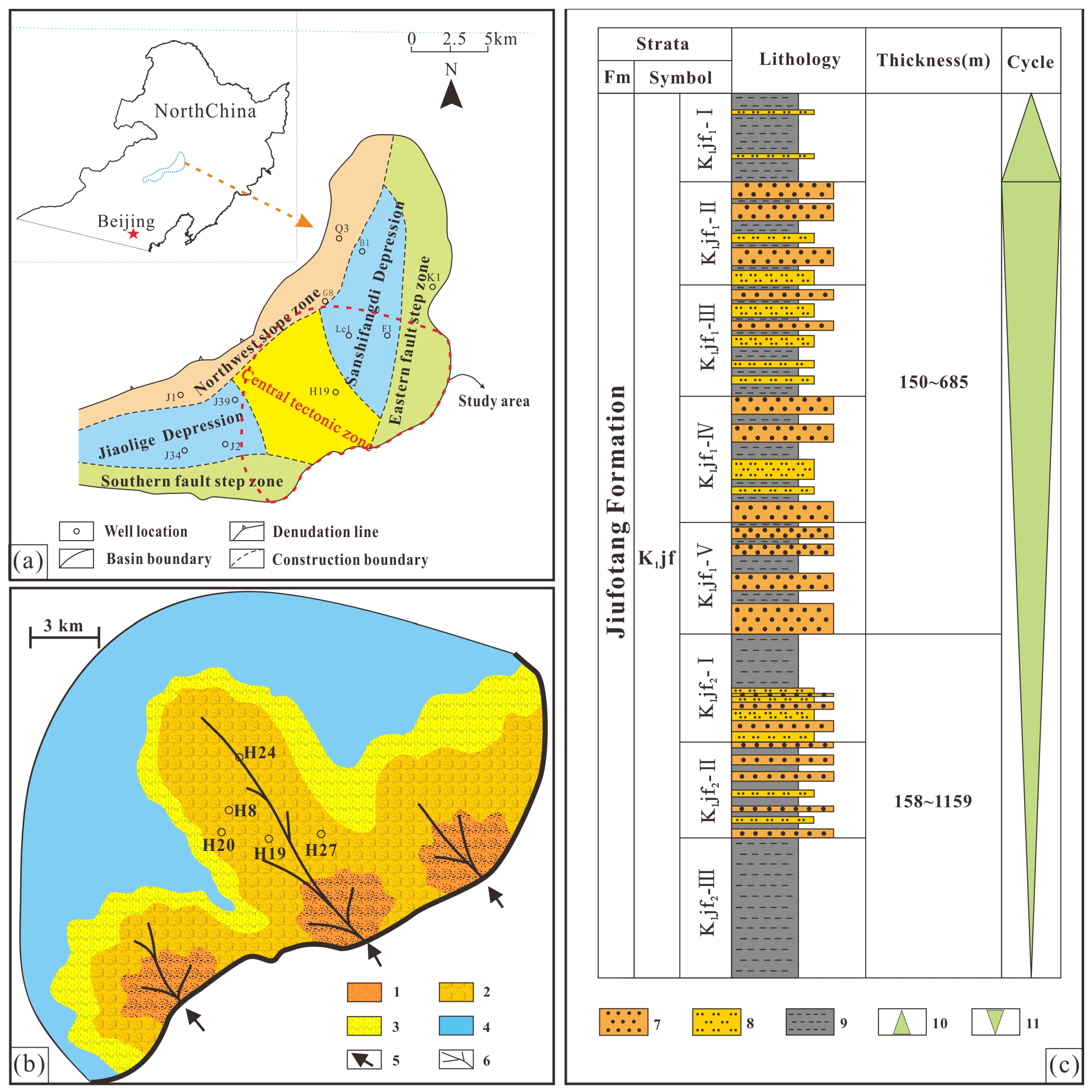
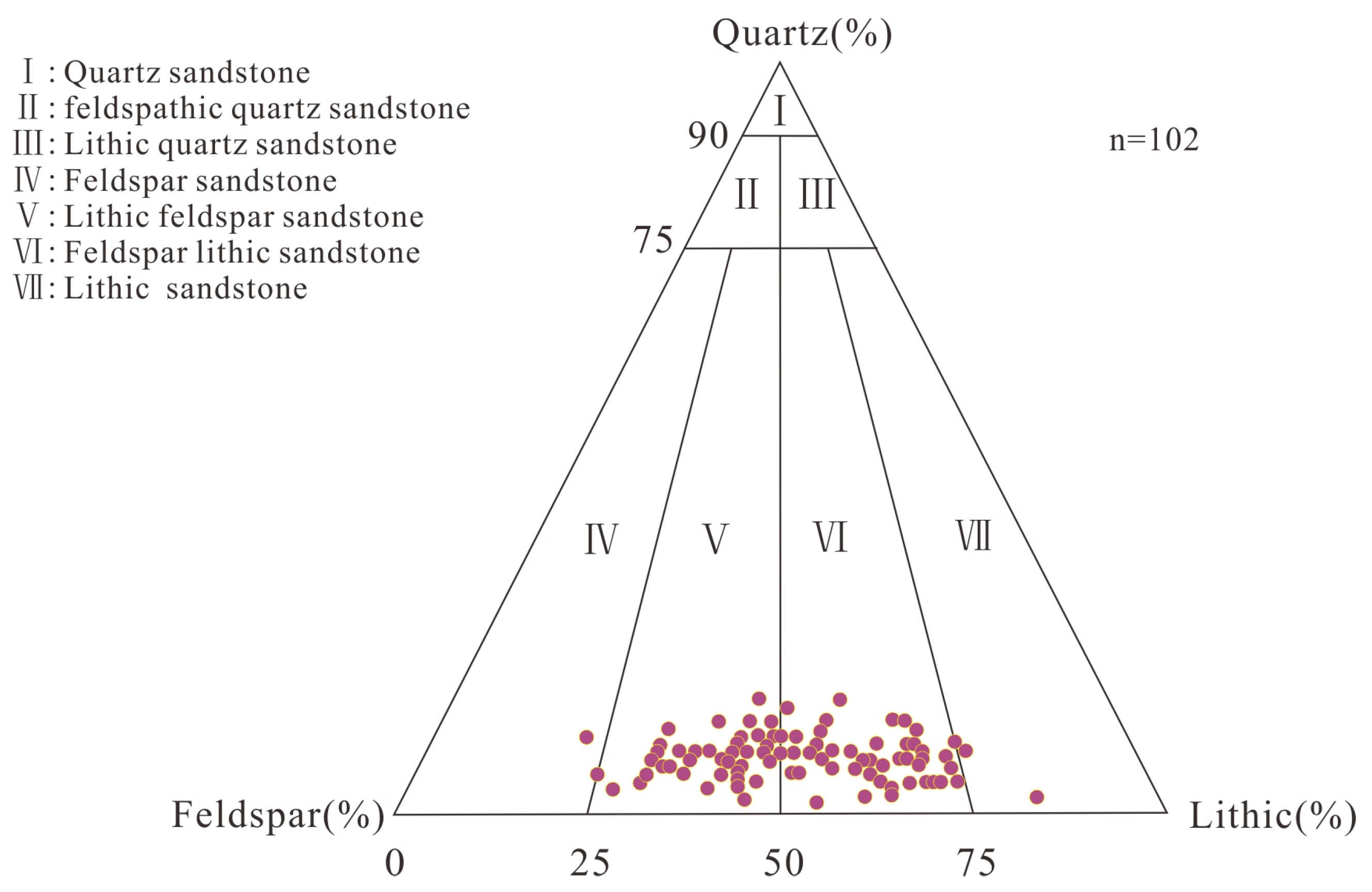
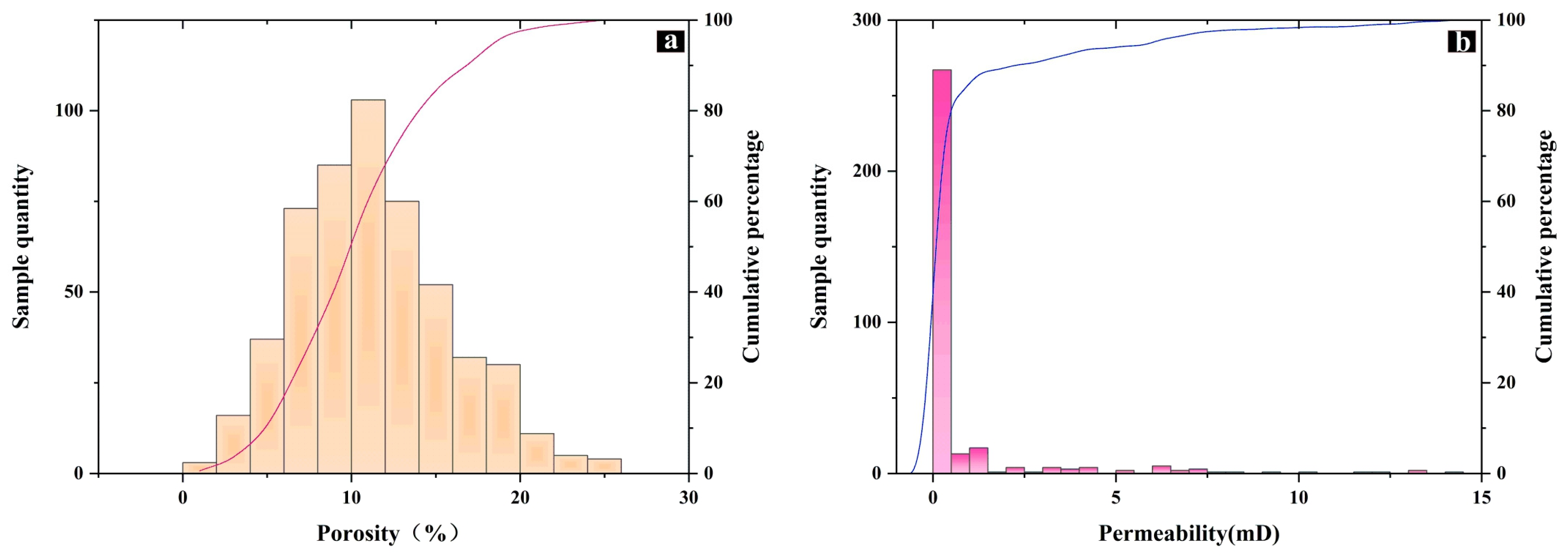
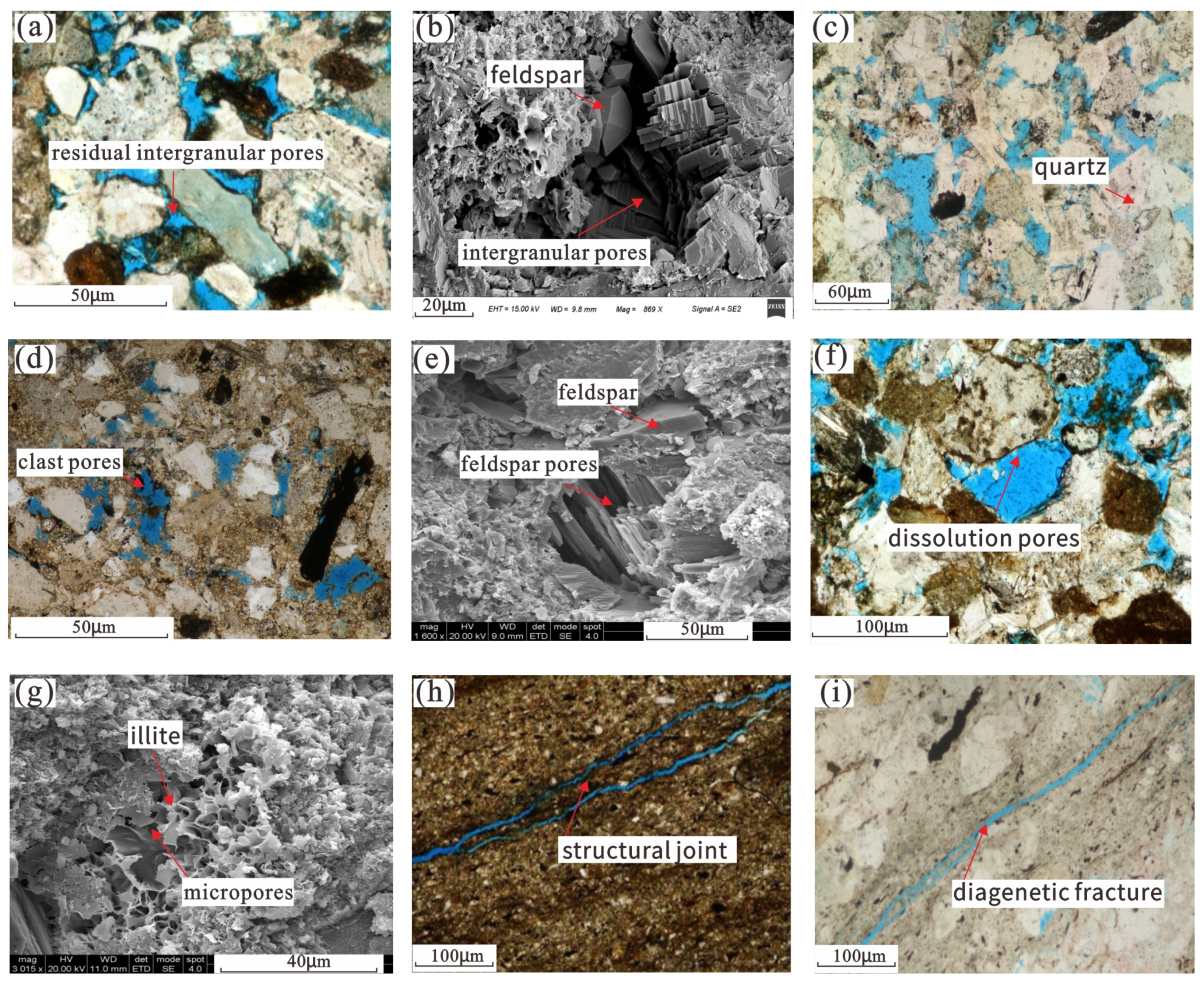
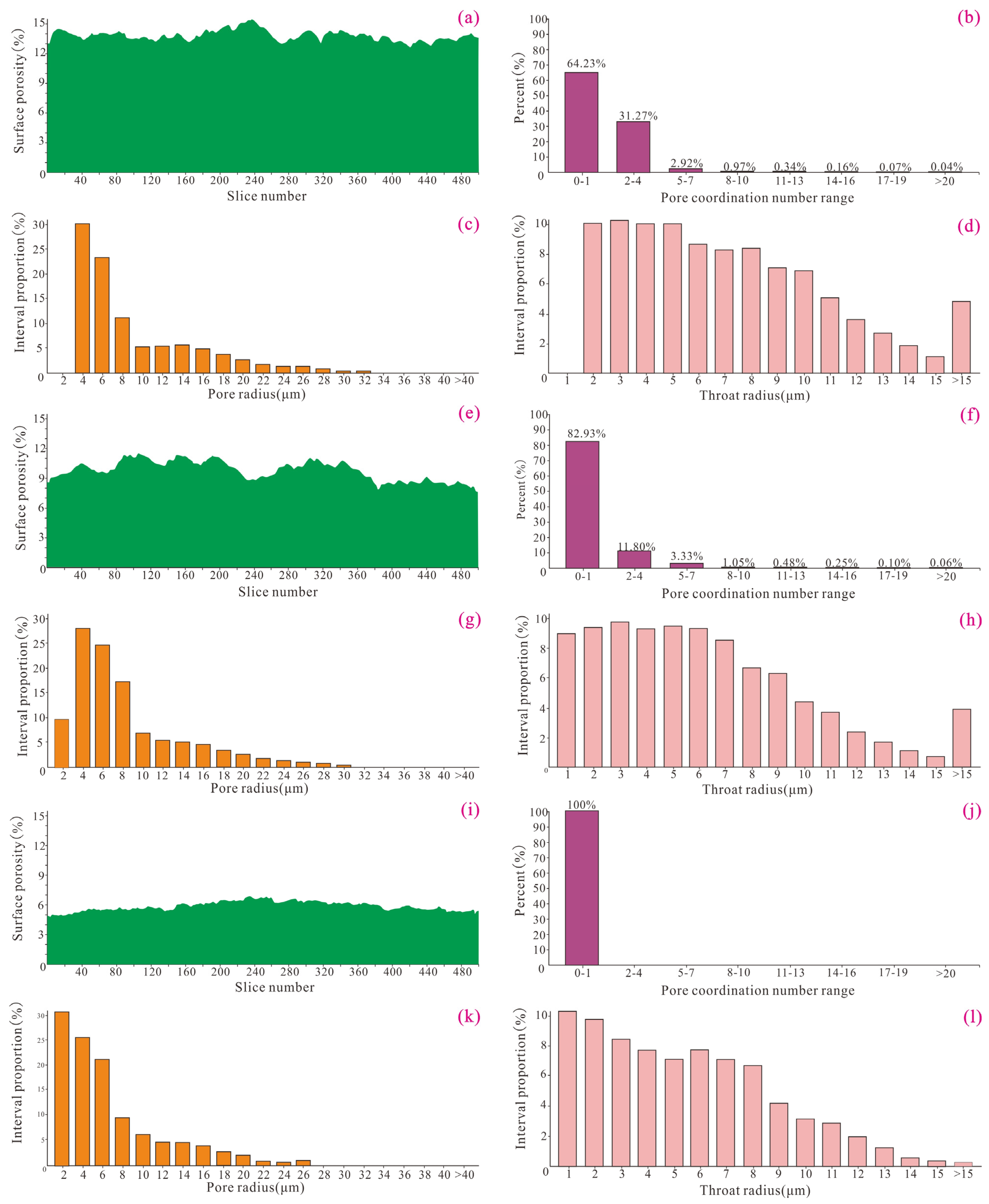
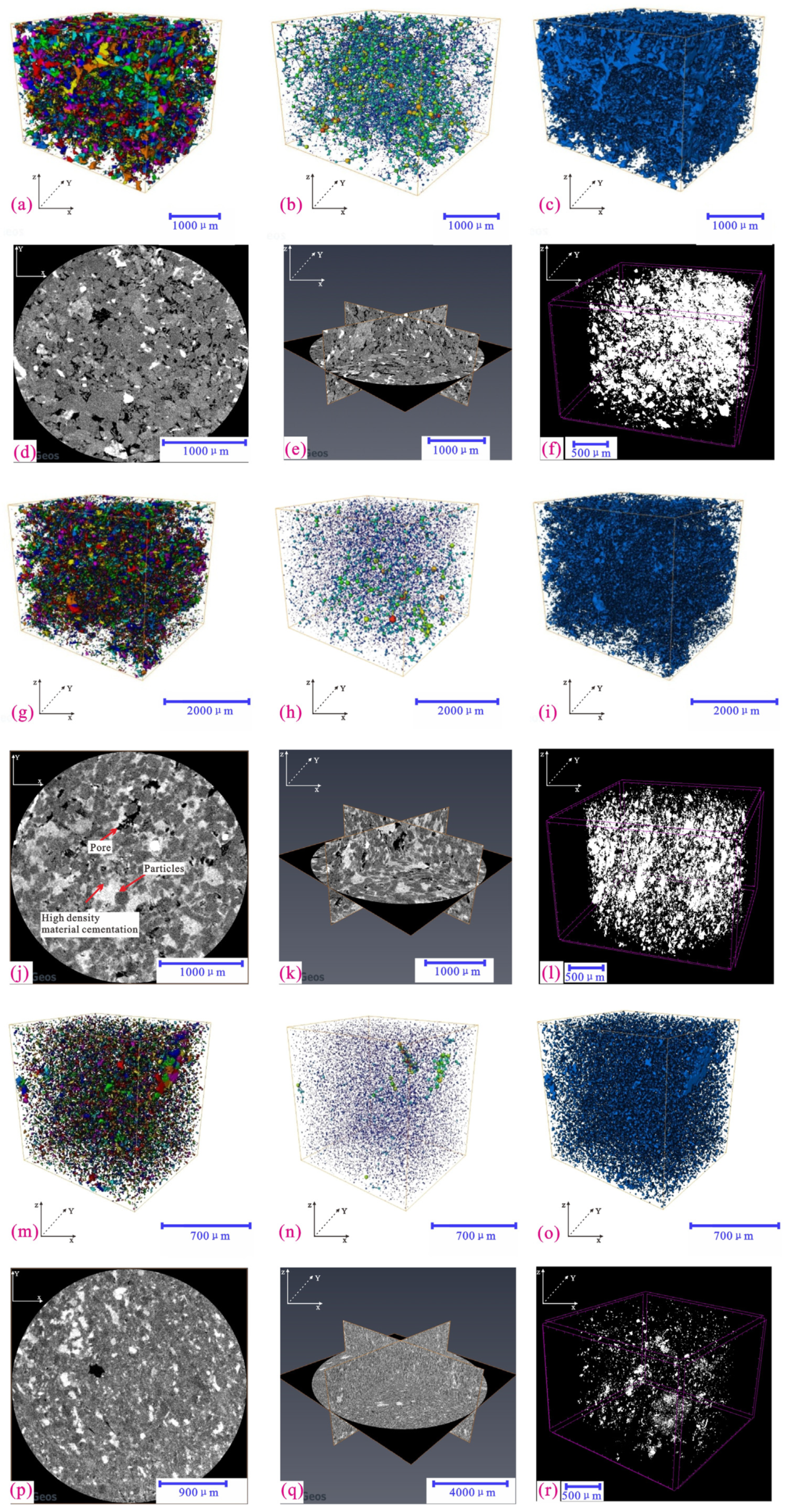

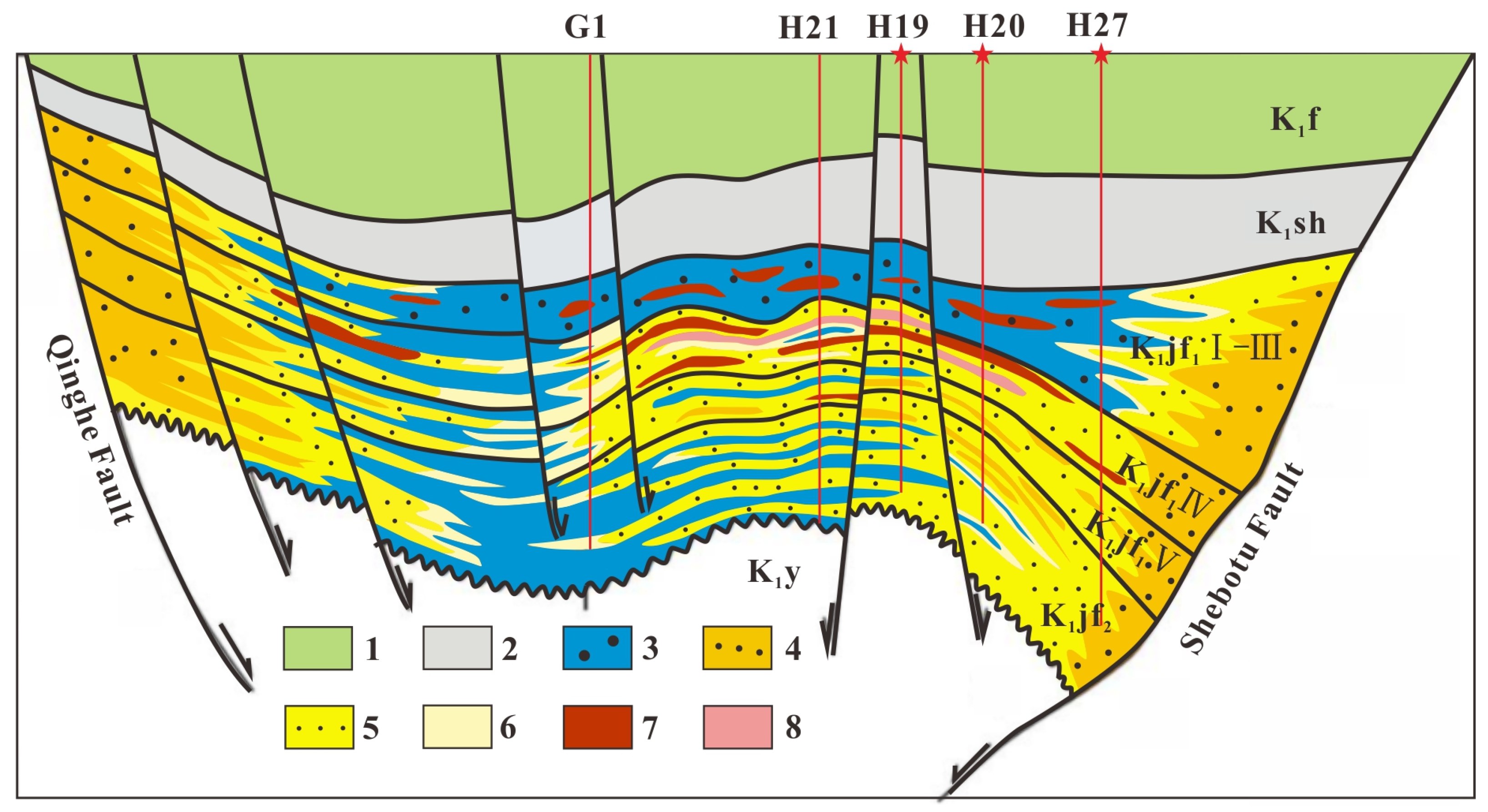
| Parameters | φ (%) | K (mD) | Pd (MPa) | P50 (MPa) | VG | SHgmax (%) | Sk | R (μm) | Cn |
|---|---|---|---|---|---|---|---|---|---|
| φ (%) | 1.000 | 0.856 | −0.549 | −0.592 | 0.776 | 0.570 | 0.554 | 0.247 | 0.026 |
| K (mD) | 0.856 | 1.000 | −0.229 | −0.527 | 0.714 | 0.730 | 0.725 | 0.288 | −0.026 |
| Pd (MPa) | −0.549 | −0.229 | 1.000 | 0.353 | −0.489 | −0.228 | 0.188 | −0.506 | −0.431 |
| P50 (MPa) | −0.592 | −0.527 | 0.353 | 1.000 | −0.535 | −0.812 | −0.606 | 0.212 | 0.392 |
| VG | 0.776 | 0.714 | −0.489 | −0.535 | 1.000 | 0.649 | 0.563 | 0.170 | −0.142 |
| SHgmax (%) | 0.570 | 0.730 | −0.228 | −0.812 | 0.649 | 1.000 | 0.630 | 0.042 | −0.270 |
| Sk | 0.554 | 0.725 | 0.188 | −0.606 | 0.563 | 0.630 | 1.000 | −0.369 | −0.614 |
| R (μm) | 0.247 | 0.288 | −0.506 | 0.212 | 0.170 | 0.042 | −0.369 | 1.000 | 0.924 |
| Cn | 0.026 | −0.026 | −0.431 | 0.392 | −0.142 | −0.270 | −0.614 | 0.924 | 1.000 |
| Type | φ (%) | K (mD) | VG | Sk | R (μm) |
|---|---|---|---|---|---|
| I | (9.6–23.2)/12.6 | (0.74–28.3)/2.81 | (0.69–1.72)/0.82 | (0.89–4.86)/2.44 | (2.08–56.50)/12.75 |
| II | (6.4–12.3)/8.75 | (0.09–4.12)/0.30 | (0.91–2.06)/1.19 | (0.61–2.11)/1.31 | (0.60–23.41)/7.63 |
| III | (2.83–9.91)/3.80 | (0.016–3.27)/0.08 | (1.45–3.47)/2.27 | (0.43–1.32)/0.87 | (0.26–12.92)/3.86 |
Disclaimer/Publisher’s Note: The statements, opinions and data contained in all publications are solely those of the individual author(s) and contributor(s) and not of MDPI and/or the editor(s). MDPI and/or the editor(s) disclaim responsibility for any injury to people or property resulting from any ideas, methods, instructions or products referred to in the content. |
© 2024 by the authors. Licensee MDPI, Basel, Switzerland. This article is an open access article distributed under the terms and conditions of the Creative Commons Attribution (CC BY) license (https://creativecommons.org/licenses/by/4.0/).
Share and Cite
Zhang, G.; Ma, C. Characteristics of Micropore-Throat Structures in Tight Oil Reservoirs: A Case Study of the Jiufotang Formation in the Houhe Region, NE China. Minerals 2024, 14, 918. https://doi.org/10.3390/min14090918
Zhang G, Ma C. Characteristics of Micropore-Throat Structures in Tight Oil Reservoirs: A Case Study of the Jiufotang Formation in the Houhe Region, NE China. Minerals. 2024; 14(9):918. https://doi.org/10.3390/min14090918
Chicago/Turabian StyleZhang, Guolong, and Chenglong Ma. 2024. "Characteristics of Micropore-Throat Structures in Tight Oil Reservoirs: A Case Study of the Jiufotang Formation in the Houhe Region, NE China" Minerals 14, no. 9: 918. https://doi.org/10.3390/min14090918






